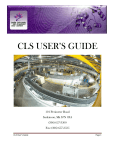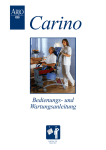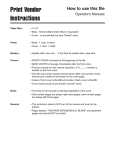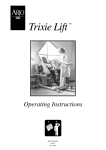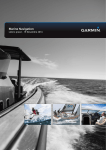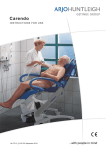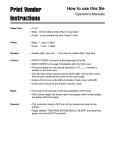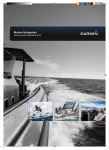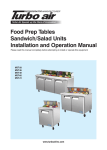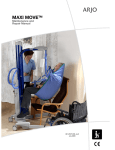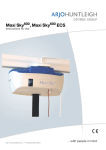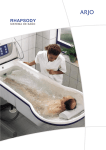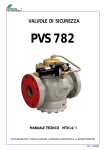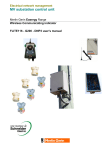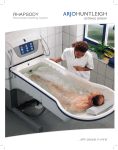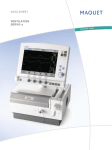Download Maxi Twin
Transcript
Maxi Twin TM Operating and Product Care Instructions KTX82538-GB Issue 2 March 2006 Introduction GETINGE GROUP is a leading global provider of equipment and systems that contribute to quality enhancement and cost efficiency within healthcare and life sciences, Equipment, services, and technologies are supplied under the brands ARJO for patient hygiene, patient handling and wound care, GETINGE for infection control and prevention within healthcare and life science and MAQUET for surgical workplaces, cardiopulmonary and critical care. The vertical and horizontal lines printed in the margins adjacent to the text/illustrations in these instructions are for ARJO use only and should be disregarded by the reader. Some of the information contained in these instructions may become outdated, due to improvements made to the product in the future. If you have any questions regarding these instructions or your lifter, please contact ARJO or their approved distributor. © ARJO Med. AB LTD ARJO products are patented or patent pending. Patent information is available by contacting ARJO Med. AB LTD. Our policy is one of continuous development and we therefore reserve the right to make technical alterations without notice. The content of this publication may not be copied either whole or in part without the consent of ARJO Med. AB LTD. ARJO Med. AB LTD. strongly advise and warn that only ARJO Company Designated Parts, which are designed for the purpose, should be used on equipment and other appliances supplied by ARJO, to avoid injuries attributable to the use of inadequate parts. Un-authorised modifications on any ARJO Med. AB LTD. equipment may affect it’s safety and are in breach of any warranty on it. ARJO Med. AB LTD. will not be held responsible for any accidents, incidents or lack of performance that occur as a result of any unauthorised modification to it’s products. The ARJO Company’s Conditions of sale make specific provision confirming no liability in such circumstances. ‘Maxi Twin’ and ‘Flites’ are trademarks of the ARJO Group. 2 Contents SECTION Foreword................................................ Safety Instructions ................................. Product description/function ................. Parts referred to in this manual........... Slings .................................................. Control Handset.................................. Emergency stop button (red) .............. System failure lower override.............. Automatic cutout ................................ Adjustable width chassis legs............. Chassis castor Brakes ........................ Jib and spreader bars ........................ Using your Maxi Twin ............................ Before approaching the patient .......... Powered opening ‘V’ chassis.............. Maxi Twin ‘quick release’ system ...... Using the DPS spreader bar ............... To lift from a chair ............................... To lift from a bed ................................. To raise from the floor ......................... Powered DPS spreader bar (if fitted) .. Using the loop spreader bar ............... To lift from a chair ............................... To lift from a bed ................................. To raise from the floor ......................... Lifter Battery charging ........................... Care of your Maxi Twin .......................... Sling care and cleaning....................... Lifter care and cleaning ...................... Periodic Testing .................................. Service Advice .................................... Labels..................................................... Technical Specification .......................... Component weights ........................... Electrical ............................................ Maximum capacities .......................... Lifter Dimensions ................................ 3 Page No. 4 5 6-10 6 7 9 9 9 9 10 10 10 11-20 11 11 11 12 12 14 15 17 18 18 19 20 21 22-24 22 22 23 23 25 26-27 26 26 26 27 Foreword Operational Life Thank you for purchasing ARJO equipment Your Maxi Twin is part of a series of quality products designed especially for hospitals, nursing homes and other health care uses. The expected operational life of your ARJO lifter is 10 (ten) years from the date of manufacture, providing the following conditions are adhered to:- We are dedicated to serving your needs and providing the best products available along with training that will bring your staff maximum benefit from every ARJO product. The operational life of the sling is dependent on the actual use conditions. Therefore, Before use, always make sure that the sling, loops, cords and straps do not show signs of fraying, tearing or other damage and that there is no damage, (i.e. cracking, bending, breaking) to the attachment clips. If any form of damage is found do not use the sling. Please contact us if you have any questions about the operation or maintenance of your ARJO equipment. All references to the patient in these instructions refer to the person being lifted, and references to the attendant refer to the person who operates the Maxi Twin. The expected life for other consumable products, such as batteries, fuses, lamps, gel cushions, filters, seal kits, seat inserts, mattresses, safety belts, padded covers, straps and cords is dependent upon the care and usage of the equipment concerned. Consumables must be maintained in accordance with published “Operating and Product Care Instructions” and the “Preventive Maintenance Schedule”. Techniques described in these instructions for fitting slings and lifting patients from a reclining position can be used for patients regardless of where they may be lying, on the bed or on the floor. Similarly, lifting a patient from a chair employs the same techniques as when lifting a patient from a wheelchair or from a sitting position on the edge of a bed. The date of manufacture is shown in the first 6 digits of the serial number, e.g. GB0521 123456 (GB = country of manufacture, 05 = year 2005 and 21 = 21st week of that year). The remaining digits, are the machine identification number. Note: The need for a second attendant to support the patient must be assessed for each individual case. These instructions specifically show both the fourpoint clip attachment slings being used with the standard Dynamic Positioning System (DPS) and the loop attachment slings with the three point spreader bar. The same methods and techniques described for the standard DPS can also be applied to the optional “Open Style” DPS. Policy on number of staff members required for resident/patient transfer ARJO’s passive and active series of lifters are designed for safe usage with one caregiver. There are circumstances, such as combativness, obesity, contractures etc. of the individual that may dictate the need for a two person transfer. It is the responsibility of each facility and a professional medical person to make a determination if a one or two person transfer is more appropriate, based on task, resident load, environment, capability, and skill level of the staff member. Conditions • The unit is cared for and serviced in accordance with recommended, published “Operating and Product Care Instructions” and the “Preventive Maintenance Schedule”. • The unit is maintained to the minimum requirements as published in the “Preventive Maintenance Schedule”. • The servicing and product care, in accordance with ARJO requirements, must begin on first use of the unit by the customer. • The equipment must be used for its intended purpose only and is operated within the published limitations. • Only ARJO designated spare parts should be used. 4 Safety Instructions Before using your Maxi Twin, familiarise yourself with the various parts and controls and please read this manual thoroughly in its entirety before using your Maxi Twin. Information in the manual is crucial to the proper operation and maintenance of the equipment, and will help protect your product and ensure that the equipment performs to your satisfaction. Some of the information in this booklet is important for your safety and must be read and understood to help prevent possible injury. If there is anything in the manual that is confusing or difficult to understand, please call ARJO Ltd or their appointed distributor (the telephone number appears on the last page of this manual. Warning: Do not overload the Maxi Twin beyond the approved lifting capacity of the lowest rated attachment/ accessory. The Maxi Twin may be used on gentle slopes with caution. Care should be taken when manually lifting alternative/optional components e.g. spreader bars, to avoid injury. Do not attempt to manually lift the complete lifter. Symbols used adjacent to the text in these instructions:- Caution: Although manufactured to a high standard the Maxi Twin and accessories should not be left for extended periods in humid or wet areas. Warning: Means:- failure to understand and obey this warning may result in injury to you or to others. Do not under any circumstances spray the Maxi Twin or accessories (excluding slings or ARJO approved wet environment equipment) with water e.g. under the shower. Caution: Means:- failure to follow these instructions may cause damage to all or parts of the system or equipment. • Warning: It is advisable to familiarise yourself and understand the operation of the various controls and features of the Maxi Twin and ensure that any action or check specified is carried out before commencing to lift a patient. Note: Means:- this is important information for the correct use of this system or equipment. This product has been designed and manufactured to provide you with trouble free use, however, this product does contain components that with regular use are subject to wear. Warning: The ARJO Maxi Twin has been designed as a mobile lifter for raising and transporting patients in hospitals and care facility environments, and should only be used for this purpose. Warning: SOME OF THESE PARTS ARE SAFETY CRITICAL TO THE OPERATION OF THE LIFTER AND WILL NEED EXAMINING AND SERVICING ON A REGULAR BASIS AND MUST BE REPLACED WHEN NECESSARY. The ARJO Maxi Twin can be supplied with a variety of optional attachments, which may not be described in these instructions. If your Maxi Twin has been fitted with an alternative/optional sub assembly then always refer to the separate relevant operating instructions supplement, as well as these instructions, before attempting to operate the lifter. See also “Care of your Maxi Twin” section. Warning: Use only ARJO slings that have been specifically designed for the Maxi Twin. This product is intended to be operated entirely by an attendant. No functions regarding the control of this product should be performed by the patient. A second attendant may be required with certain patients. Warning: Before lifting a patient, a clinical assessment of the patients’ condition and suitability to be lifted should be carried out by a qualified person. Warning: Patients with spasms can be lifted, but special attention should be paid to supporting the patient’s legs. 5 Product Description/Function Parts referred to in this manual 1. Mast/Lifter manoeuvring handle 2. Jib 3. Adjustable chassis legs 4. Braked castors (rear) 5. Non-braked castors (front) 6. Powered DPS spreader bar 7. Control handset 8. Handset hang point 9. Lifter battery pack 10. Main lift actuator 11. Emergency stop button/Reset button 12. System failure lower override mt001 13. Pivot pin/quick release pin 2 8 13 7 1 6 10 12 11 9 5 3 4 6 Product Description/Function Slings • Note: All Maxi Twin slings will support 170 KG (374lbs), all slings are coded for size by having different coloured edge binding as follows: Teal -Extra Extra Small - XXS Brown - Extra small - XS Red -Small - S Yellow - Medium - M Green -Large - L Purple - Large Large - LL Blue -Extra Large - XL A label is fitted to the hanger frame for quick colour to size reference (see “Labels” section). A range of special purpose slings are available as accessories, for these or for special size slings, contact your ARJO representative. Warning: Only use ARJO supplied slings that are designed to be used with Maxi Twin. The sling profiles illustrated will help to identify the various ARJO slings available. If ARJO Flites (disposable slings) are to be used with the Maxi Twin, then always refer to the separate operating instructions for ARJO Flites, (literature reference part No. MAX01720), as well as these instructions before using. Warning: ARJO slings with head support have two pockets at the head section which contain plastic reinforcement pieces during use. Always ensure these reinforcement pieces have been inserted into the sling pockets before using the sling. 7 ARJO standard sling profiles that can be used with the Maxi Twin Soft stretcher Toilet sling with head support General purpose sling with head support Four point toiletting sling (With headrest) Four point amputee sling Four point Padded sling Four point unpadded sling Four point mesh sling 8 mp1271max1e Product Description/Function Product Description/Function Controls and features Emergency Stop Button (Red):- (see below) If, in an emergency, you have to immediately stop any powered movement, (other than by releasing pressure on the control handset button), press the “emergency stop button”, situated on the side of the main lift actuator cover. Control Handset:- Raising and lowering the jib and opening and closing the chassis legs, is achieved by pressing the appropriate button on the control handset. Note: icons with direction arrows are printed on each button for quick reference. P1396amaxB mt002 “Lower” Button “Raise” Button Once the emergency stop button has been operated, it will have to be reset before any powered movement can be utilised. System Failure Lower Override Sit up Recline Chassis leg open Button Emergency Stop Chassis leg close button System Failure Lower Override:- (see above) This can be used in the event of main control failure. In the unlikely event that the control handset fails to operate the lifter, with a patient still supported by the sling, provision for lowering has been made, using the “System Failure Lower Override” control, situated on the top of the main lift actuator housing, a green and white identification label is positioned near the control for quick and easy recognition. Pull the control up to operate, release the control during use and lowering will stop. If pressure is released during any function powered motion will cease immediately. Do not drop the handset into water, e.g.: bath etc., although if this does happen inadvertently no harm will come to patient or attendant. When not in use, the handset can be conveniently kept ready for use by hooking it over the handset hang point at the top of the mast. Automatic cut out:- (not an operator control but a function built into the lifter electronics) If the lifter is inadvertently overloaded (trying to lift a patient heavier than permitted), an automatic ‘cut out’ operates to prevent the lifter lifting a load in excess of one and a half times the maximum rated load; this will stop the lift motion automatically. If this occurs, when pressure is released from the lift button on the handset, after a short delay the electronics will reset and enable the patient to be lowered only by pressing the lower button. Remove the patient from the lifter. 9 Product Description/Function Jib and spreader bars:- If your Maxi Twin has not been supplied with a ‘dedicated’ or permanently attached, spreader bar, then it will be supplied with the ‘quick release’ system jib. This jib is fitted with a carrier, able to accommodate any of the Maxi Twin Loop spreader bars (see “Using your Maxi Twin” section for full instructions on fitting or changing attachments). Adjustable width chassis legs:- By operating the appropriate button on the control handset the chassis legs can be opened to any variable width. When pressure is released from the button, movement will stop and the chassis legs will remain securely in position. Always transport with the chassis legs in the narrow (closed) position. Quick release mt006d,mt006e mt003 The illustration below shows the two systems available. Dedicated mP1332e,f Chassis castor Brakes:- The chassis rear castors have brakes which can be foot operated if required, for example, when leaving the patient unattended, or to keep the Maxi Twin in position. Caution: The locking pin used with the ‘quick release’ system, must not be used with DPS spreader bars. 10 Using your Maxi Twin Maxi Twin ‘quick release’ system Ensure the battery pack supplied is fully charged before use (for charging, see instructions in “Lifter Battery Charging” section). When the battery pack is fully charged remove it from the charger unit and insert it into the battery position of the Maxi Twin situated on the side of the main lift actuator housing. If your Maxi Twin has not been supplied with a ‘dedicated’ or permanently attached, spreader bar, then it will be supplied with the ‘quick release’ system jib. If you need to fit or change the attachment, (i.e. spreader bar) proceed as follows. • A Jib Note: The battery is shaped so that only correct fitment to the lifter is possible with the raised edge of the battery upper most. ‘R’ clip mt006a, mt006b, mt006c Before approaching the patient Loop spreader Push the battery firmly into place. Electrical connection will be made automatically. Ensure a selection of sling types and sizes are easily available for all types of lift likely to be encountered when using the ARJO Maxi Twin. B The attendant should always tell the patient what they are going to do, and have the correct size sling ready. Where possible, always approach the patient from the front. Warning: To ensure maximum patient comfort, do not allow the patient to hold onto the spreader bar. C If required, the chassis legs may be opened to go around a chair or wheelchair. Powered opening ‘V’ chassis Select the appropriate button on the control handset and keep it depressed until the required width is achieved. To close, press the appropriate button. Movement will stop if pressure is released, whether opening or closing. To remove an existing attachment; first, remove the ‘R’ clip from the locking pin. Then support the attachment and depress the button on the end of the locking pin (shown in (A) above). Keeping the attachment supported and the button depressed, withdraw the locking pin (shown in (B) above), then lower the attachment down and away from the jib (shown in (C) above). Store the attachment carefully for future use. Warning: When opening or closing the legs on a powered chassis, care must be taken not to allow anyone to stand in the way of the moving chassis legs. Transport the Maxi Twin with the chassis legs in parallel (closed) position only. Fitting an attachment is the reverse of the above procedure, carefully lift the attachment up into position, depress the button on the end of the locking pin and push the locking pin into position. Finally, replace the ‘R’ clip through the end of the locking pin. 11 Using your Maxi Twin mt006d mt004a Correctly installed, the two balls on the locking pin shaft should be clearly visible, and the ‘R’ clip fitted as illustrated below. Warning: Before use always check that the locking pin is pushed fully into position and the ‘R’ clip is fitted. Ensure that the Maxi Twin is close enough to be able to attach the shoulder clips of the sling to the spreader bar. To accomplish this you may have to put the patients feet on, or over the chassis. Warning: Care must be taken when the weight of the attachment comes away from the jib. Warning: When fitting and lifting using the sling with the DPS spreader bar, ensure the patients hands and arms are at all times kept inside the sling. Do not allow the patient to ‘hold on’ to the hanger frame. For larger attachments or if in any doubt about being able to lift and hold the attachment securely use more than one person for the operation, or support the attachment on a bed or chair. Using the DPS spreader bar Once the Maxi Twin is in position, attach the shoulder strap attachment clips to the pegs on the spreader bar. Ensure the DPS spreader bar is securely connected to the jib before commencing with the lifting procedure. • To Lift from a Chair P1146a,b mt004b, p1002 Place the sling around the patient so that the base of his/her spine is covered, and the head support area is behind the head. Pull each leg piece under the thigh so that it emerges on the inside of the thigh. Note: The chassis rear castors have brakes which can be foot operated when required. Do not apply the castor brakes at this stage, as the position of the patient will adjust to his/her own centre of gravity when lifted. Ensure the positioning handle on the spreader bar is facing away from the patient, and that the wide part of the spreader bar is at, or just below shoulder level. 12 Using your Maxi Twin mt004d Warning: Apply the castor brakes when leaving the patient unattended or to keep the Maxi Twin in position on a sloping surface. mt004c Press down on the positioning handle of the spreader bar and attach the leg strap attachment clips. mt004e Before transportation, turn the patient to face the attendant at approximately normal chair height. This gives confidence and dignity and also improves the Maxi Twin mobility. If necessary, lower the spreader bar using the handset control, being careful not to lower it onto the patient. Although if this should happen do not continue to press the handset lowering button. • Note: If the handset button is released during lifting or lowering, powered motion will stop immediately. Warning: IMPORTANT: Always check that the sling attachment clips are fully in position before and during the commencement of the lifting cycle, and in tension as the patient’s weight is gradually taken up. Remember to release the brakes, if they have been applied, before attempting to transport the patient. Raise the patient by operating the handset control, move the lifter away from the chair then carefully lift the positioning handle until the patient is reclined in the sling - the head support will now come into use. This is the most comfortable position for transportation, as it reduces pressure on the thighs. The angle of recline can be adjusted for increased comfort if the patient is restless. When lowering the patient back into a chair - or when transferring from bed to chair - push down on the positioning handle to put the patient into a good sitting position. This avoids further lifting effort. Take care not to push down too quickly, as this may jerk the patient’s head forward. Warning: When lowering the lifter ensure that the patient’s or attendant’s legs and feet are well clear of the moving mast. 13 Using your Maxi Twin mt005a To Lift from a Bed Before lifting a person from a bed, ensure there is sufficient clearance underneath to accommodate the Maxi Twin chassis legs. P1133maxb Position the patient onto the sling by rolling the patient towards you then folding the sling in half and placing it behind the patient’s back. Position the sling carefully so that when rolled back the patient will lie centrally on the sling and check that the head support area of the sling covers the patient’s neck. Using the adjustable width chassis, it is possible to make adjustments to chassis leg widths to assist manoeuvrability around obstructions, for example, bed legs. Position the Maxi Twin so that the spreader bar is just above, and centrally situated over the patient. • mt005b, P1002 P1022a Warning: Care must be taken not to lower the spreader bar onto the patient. Note: When rolling the patient back onto the sling, roll the patient slightly in the opposite direction so that the folded part of the sling can be brought out. Using the positioning handle, tilt the spreader bar until the shoulder attachment points can be connected to the sling shoulder strap attachment clips. Press down on the positioning handle until connection of the sling leg pieces is possible. The leg pieces must be brought under the thighs to connect up, this may involve lifting one leg at a time to connect up. You may need to lower the spreader bar a little more, using the handset control. Alternatively, the patient can be brought into a sitting posture then position the sling as detailed in the section “To Lift From A Chair”. Approach the bed with the open side of the spreader bar towards the patient’s head. 14 Using your Maxi Twin mt005c Warning: When lowering the lifter ensure that the patient’s or attendant’s legs and feet are well clear of the moving parts. Only when the patient’s body weight is fully supported by the bed may the sling leg connection clips be detached, followed by the shoulder connections. Move the Maxi Twin away before removing the sling from under the patient. If transferring the patient to a chair refer to the section “To Lift from a Chair”. When lifting from the bed, some attendants prefer to connect the leg pieces first. This particularly applies to patients with large thighs. In this case, raise the hip and knee into maximum flexion, and attach the leg strap attachment clips, then tilt the spreader bar towards the shoulders for connection. To raise from the floor Put the sling around the patient as before, by using the rolling or sitting up method. Depending on circumstances, space and/or position of patient etc. approach the patient with the open part of the chassis. Open the chassis legs if necessary. mt007a Warning: IMPORTANT: Always check that the sling attachment clips are fully in position before and during the commencement of the lifting cycle, and in tension as the patient’s weight is gradually taken up. mt005d Lift the patient using the handset control, and adjust to a comfortable position for transfer. The specially designed sling together with its’ integral head support, enables one person to carry out the complete lifting function without additional help. The patient’s head and shoulders could be raised on pillows for comfort, if required, but this is not essential when connecting up the sling to the spreader bar. If returning the patient to a bed, move into the desired position above the bed adjusting the sling position as necessary, and then lower using the handset control. 15 Using your Maxi Twin When all the straps have been properly connected, raise the patient from the floor in a semi-recumbent position. Supporting the head can be comfortable and reassuring for the patient. The leg sections of the sling will tend to be fairly high in the crotch, so straighten them out for added comfort. The patient may be positioned in a chair, or placed onto a bed. If the patient is prone to extensor spasm, he/she may be lifted by the Maxi Twin, but special attention should be paid to supporting the head during the early part of the lift. mt007b, P1002 With the open part of the spreader bar pointing down towards the shoulders, attach the shoulder strap attachment clips. When lifting patient’s with leg amputations, use an amputee sling (available as an accessory from ARJO Ltd). This sling is specially designed to accommodate the differing patient centre of gravity. Warning: When lowering the lifter ensure that the patient’s or attendant’s legs and feet are well clear of the moving parts. Transportation of a patient should always be done with the chassis legs parallel (closed) manoeuvrability will be easier, especially through doorways, with the chassis legs closed. The patient should be positioned facing the attendant. Apply the chassis brakes if leaving the patient unattended. mt007c Once connected, raise the hip and knee into maximum flexion, and push down on the positioning handle in order to connect the leg strap attachment clips. This will have the effect of raising the patient’s head and shoulders slightly. Warning: IMPORTANT: Always check that the sling attachment clips are fully in position before and during the commencement of the lifting cycle, and in tension as the patient’s weight is gradually taken up. When lifting from the floor, some attendants prefer to connect the leg pieces first. This in particular applies to the very large patient with large thighs. In this case, raise the hip and knee into maximum flexion, and attach the leg straps first, then tilt the spreader bar towards the shoulders to enable the shoulder straps to be connected. 16 Using your Maxi Twin Powered DPS spreader bar (if fitted) The powered DPS is fully waterproof and is classified by ARJO as a wet environment unit and has a blue and white circular label to qualify this, attached. (See “Labels” Section). This label signifies that the lower end of the unit may be immersed in bath water, or used for showering. If your lifter has been supplied fitted with a powered DPS spreader bar, the use of this type of spreader bar including sling positioning with patient, sling connection to the spreader bar, and patient handling, is the same as the non-powered DPS spreader bar described previously in these instructions. To operate the powered patient positioning function, ensure the isolator/cut off switch is in the on position mt001 When ready to perform the patient positioning function (as described previously) operate the powered DPS control button to achieve spreader bar movement in the required direction. Sling attachment lugs “Lower” Button Rotational positioning handle “Raise” Button P1396amaxB Powered movement will continue until pressure is released from the control switch. Powered DPS actuator. Sit up Recline Chassis leg open Button The fundamental difference being, the powered DPS spreader bar has the added advantage of enabling the patient positioning manoeuvre to be performed with minimal physical effort by the attendant. Rotation of the powered spreader bar is manual and is the same as the manual patient positioning spreader bar. Chassis leg close button Warning: To stop any powered movement, release pressure from the control switch or press the emergency stop button. Warning: Before using your lifter when fitted with the powered DPS spreader bar, familiarise yourself with the various parts. then read and thoroughly understand the following operating instructions. The spreader bar will remain firmly in position, once powered movement has ceased. Warning: Before and during operating the powered DPS spreader bar, ensure all obstructions are well clear of the spreader bar, support frame and jib. The powered DPS spreader bar must be used in accordance with the following instructions and in conjunction with the operating instructions previously described for the manually operated (non-powered) four point spreader bar. Warning: The actuator covers contain moving parts, care must be taken not to damage these covers. Should the covers become damaged, withdraw the lifter from use and arrange replacement of the actuator before re-using the lifter. The lifting capacity of the lifter when fitted with the powered DPS spreader bar remains the same as the non-powered patient positioning spreader bar version. 17 Using your Maxi Twin Using the loop spreader bar To Lift from a Chair mt008a mt008e Method 1 - Easing the patient forward, if necessary, slide the sling down the patient’s back until seam “C” reaches the base of the spine. Take attachment points “B” and loop the tails of the sling underneath the patient’s thighs, ensuring the sling pieces are not twisted underneath the patient. Hook the loops onto the “opposite side” outer hooks on the spreader bar. A A Warning: Before attaching the sling ensure the spreader bar is rotated into position so the eventual lift will resemble the above figure. C When attaching a loop sling to the loop spreader bar always ensure the sling attachment loops are positioned correctly into the retaining hooks and that the retaining hooks gates move freely as shown below. METHOD 1 mt008b B mt009 retaining hook gate B loop sling attachment hook The slings to be used with the loop spreader bar are the ARJO loop slings. They are available in different sizes, (small, medium, large and extra large etc.) all colour coded. A range of more specialised slings are available please contact ARJO or their authorised distributors for details. Method 2 - As method 1 above, but pass each tail portion of the sling under both thighs, and then out the other side before attaching points “B” to the outer hooks on the spreader bar. The loop sling is available with or without head support. A mesh sling is also available in all sizes with or without head support. 18 Using your Maxi Twin Warning: Always check that all the sling attachment loops are fully in position before and during the commencement of the lifting cycle, and in tension as the patient’s weight is gradually taken up. mt008c METHOD 2 When lowering the Lifter ensure that the patient’s or attendant’s legs and feet are well clear of the moving parts. Apart from the methods listed above, the loop spreader bar with loop slings is also extremely useful for lifting patients who have contracted legs, where the patient leg position prohibits the use of the DPS spreader bar. Attach the sling in the normal manner as described in “lifting from the bed”. To lift from a bed Method 3 - As method 1 above, but loop a tail portion of the sling under each thigh and attach to the same side hook as the shoulder attachment (left straps to left hook and right straps to right hook). This method holds the legs in abduction, and is useful for toiletting. Warning: IMPORTANT: Check that all four points of the sling are securely connected before lifting. mt008d METHOD 3 Place the sling under the patient as if it were a drawsheet. Flex the patient’s legs, and bring the sling leg pieces under the thighs, attach the sling to the spreader bar using any of the methods 1-3 above. Once the sling has been positioned and attached securely to the spreader bar then lifting can be carried out using the control handset. For general patient manoeuvring and transportation see also section “Using the DPS spreader bar”. 19 Using your Maxi Twin To raise from the floor (Some attendants prefer to use a larger sling for this operation.) mt010a Raise and support the patient into a sitting, or half sitting position. Feed the sling down the patient’s back, bring the leg pieces of the sling into position. Raise the patient’s legs over the chassis, and bring the lifter into position. With the jib as low as possible, attach the shoulder loops. Bend up the patient’s knees to connect up the leg pieces. Warning: Check all the loops are securely attached before lifting. When lifting or lowering a patient who is supported by a sling it is not necessary to use the brakes, this allows the Lifter to move to the correct position relative to the centre of gravity of the patient. Warning: Apply the castor brakes when leaving the patient unattended or to keep the Maxi Twin in position on a sloping surface. When the patient has been returned to the bed he/ she may be reclined before the sling is detached. Warning: When lowering the jib ensure that the patient’s or attendant’s legs and feet are well clear of the moving parts. 20 Lifter Battery Charging Installation Warning: The battery charger is designed for dry surroundings and may not be installed in bathrooms or any other wet areas. 4. The LED will show a yellow light. 5. The charger will charge the battery for 14 hours and the LED will switch from yellow to green to indicate that the battery is fully charged. Fitting the battery to the lifter When the battery pack is fully charged remove it from the charger unit and insert it into the battery position of the Maxi Twin situated on the side of the main lift actuator housing. The charger is to be plugged in a standard power outlet. The charger is not allowed to be used in a residential environment. • Charging Batteries General The charger converts mains voltage to low DC voltage. Note: The battery is shaped so that only correct fitment to the lifter is possible with the raised edge of the battery upper most. Push the battery firmly into place. Electrical connection will be made automatically. The charger must only be used for Arjo’s battery type NEA0100. Maintenance The charger is ready for use as soon as it is plugged in. The charger does not require any maintenance. A green indicator shows that the charger is ready for charging, there is no ON/OFF button on the charger. Warning: In case of a malfunction, do not attempt to open the charger cover. Charging intervals To prolong the life of batteries, charge at regular intervals. All repairs must be carried out by Arjo authorised personnel. If the lifter is used frequently, it is recommended to use two batteries, one in operation and one being charged. Storage of batteries It is recommended that batteries not in use are left in the charger, there is no risk of overcharging the batteries. Batteries are charged when delivered but we recommend you charge the batteries when received due to a low self discharge. Note: A buzzing tone will be heard when the battery needs charging. The batteries will slowly discharge when not used. Batteries that will not be used for a long period should be kept in a cool place, between 0°C (32°C) and 25°C (77°C). Charging procedure Plug in the charger in a power outlet. 2. The LED will show a green light. 3. Connect the charger cable to the battery. Batteries that are charged for the first time, or after a long period of storage, must be charged for 14 hours or until the LED turns green. mt011 1. 21 Care of your Maxi Twin Lifter care and cleaning How often the following actions are taken depends on how often the equipment is used. Unless otherwise stated, before each and every use follow the cleaning, care and inspection procedures described in this section. Warning: It is recommended that patient lifters, equipment, accessories are regularly cleaned and/or disinfected between each patient use if necessary, or daily as a minimum. If the lifter and/or equipment needs cleaning, or is suspected of being contaminated, follow the cleaning and/or disinfection procedures recommended below, before re-using the equipment. Sling care and cleaning Warning: The slings should be checked before and after use with each patient and if necessary washed according to instructions on the sling, This is especially important when using the same equipment for another patient, to minimise the risk of cross infection. Also refer to sling instruction sheet MAX.01510.INT. For cleaning your lifter, equipment and accessories wipe down with a damp cloth using warm water to which a disinfectant/cleaner has been added e.g. “ARJO CLEAN” - disinfectant/cleaner or equivalent With regard to laundering, slings should not be classified as linen, but as an accessory to a patient transfer lifter and therefore classified as a medical device. Slings should be cleaned and disinfected only in strict accordance with the manufacturers instructions. • Note: “ARJO CLEAN” - disinfectant cleaner is available from ARJO Ltd. or their approved distributors. Caution: Do not over wet areas of the product which could cause problems with electrical components or internal corrosion. Mechanical pressure should be avoided during the washing and drying procedure e.g. rolling or pressing, as these can damage parts vital to the safe and comfortable operation of the sling. If a hot air dryer is used to dry the lifter, the temperature must not exceed 80°C (176°F) Washing and drying temperatures must not exceed 80°C (176°F). Wash using normal detergents, do not iron. Also refer to Sling Instruction sheet MAX.01510.INT. Do not use petroleum based solvents or similar, since this may damage plastic parts. It is essential that the sling attachment cords, the slings, their straps and attachment clips are carefully inspected before each and every use. If the slings, cords or straps are frayed, or the clips damaged, the sling or attachment cord should be withdrawn from use immediately and replaced. Warning: For disinfection of contaminated lifters, equipment and accessories, use the preferred method of wiping the product completely with “hard surface disinfectant wipes” that are supplied impregnated with a 70% v/v solution of Isopropyl Alcohol. • Note: A rubbing action will be necessary when using the wipes to promote effective disinfection of the surfaces. Warning: IMPORTANT: Cleaning and disinfection products must be used in accordance with the manufacturers instructions and suitable eye, hand and clothing protection must be worn at all times when handling disinfectants. 22 Care of your Maxi Twin • Adjustable Width Chassis Function:- Open and close the chassis legs using the control handset to check for full and efficient movement. Note: 70% v/v Isopropyl Alcohol wipes have been proved to be effective against MRSA and several other microorganisms under light soiling conditions. General lifter Condition:- A general visual inspection of all external parts should be carried out, and all functions should be tested for correct operation, to ensure that no adverse damage has occurred during use. The following checks should be carried out daily. Warning: If in any doubt about the correct functioning of the Maxi Twin, withdraw it from use and contact ARJO Service Department. Ensure that the battery pack is always in a good state of charge. Warning: Ensure that the castors are firmly secured to the chassis. Servicing Advice Carefully inspect all parts, in particular where there is personal contact with the patient’s body, ensure that no cracks or sharp edges have developed which could injure the patient’s skin or become unhygienic. Warning: ARJO recommend that the Maxi Twin is maintained at regular intervals, see ARJO Maxi Twin Preventive maintenance schedule (ARJO Literature Part No. KMX82171/Maxi Twin) Check that all external fittings are secure and that all screws and nuts are tight. With regular use the following items are subject to wear:- slings, batteries, straps, castors. These items must be regularly checked as described previously, and replaced as necessary. Ensure that all instruction labels are firmly attached and in good readable condition. Periodic Testing Warning: UK LIFTERS ONLY: Important legislation came into force on 5th December 1998, which has an impact on the schedule of service for your patient lifter(s), variable height baths and other raising and lowering equipment. The Lifting Operations and Lifting Equipment Regulations (LOLER) 1998 and The Provision and Use of Work Equipment Regulations (PUWER 98) must be satisfied by the duty holder. A scheme of six monthly thorough examinations has been devised to comply with the law and details can be obtained from ARJO Service UK To be carried out at weekly intervals. Periodic testing of the operational functions is advisable from time to time to ensure everything operates satisfactorily. Test for full and efficient movement of the lift / lower mechanism:- Raise and lower the jib using the control handset to check for full and efficient movement. Emergency Stop:- Test the emergency stop facility by operating the control handset to lift or lower the jib, and whilst operating, press the emergency stop button. Powered movement should stop immediately. Reset the button and repeat for chassis legs opening/closing function. Reset the button. System Failure Lower Override:- Test this function simply by ensuring the jib is well above its lowest position then operate the system failure lower override control. The jib will lower without the need to operate the control handset. The lower override facility will still operate even with the handset control cable unplugged. 23 Care of your Maxi Twin Parts list and circuit diagrams are available from ARJO or their approved distributors on request. Warning: Spare parts, if required are available from ARJO or their approved distributors. Special tools are required for certain component replacement Warning: The simplest, safest and most effective way to maintain your product in good working order, is to have it methodically and professionally serviced by an ARJO approved engineer using ARJO approved spare parts. For information on service and maintenance contracts, please contact your local ARJO distributor. 24 mt014 Labels 9 1 6 2 5 7 3 8 4 Key to labels: 1. Serial number label 2. Emergency lower override label 3. ARJO logo 4. Product name label 5. Silverset label 6. Sling size guide and safe working load label 7. Battery part number label 8. Battery information and recycle label 9. Read operating instructions label 25 Technical Specification Component Weights kg Maxi Twin lifter only (no spreader bar or battery)........................................................ 41.7 Medium powered DPS spreader................................................................................. 6.9 Medium DPS spreader................................................................................................ 5 Small loop spreader .................................................................................................... 1.7 Medium loop spreader................................................................................................ 1.9 Large loop spreader.................................................................................................... 2.8 Battery pack................................................................................................................ 1.5 lbs (92) (15.2) (11) (3.7) (4.2) (6.2) (3.3) Electrical Battery type and part number ..................................................... (Rechargable - NiMH) NEA0100-083 Battery capacity .......................................................................... 2.5Ah Battery charger part number ....................................................... GB EU US AUS NEA2000 NEA1000 NEA4000 NEA6000 Lifter protection class ................................................................. IPX 4 Handset protection class ............................................................. IPX 7 Lifter nominal voltage .................................................................. 24V DC Medical Equipment:- type B protection against electrical shock in accordance with IEC 60601-1 ARJO patient handling products meet the requirements of Electromagnetic Compatibility (EMC) as stated in clause 12.5 of the Medical Devices Directive 93/42/EEC Although compliant with EMC requirements there is a remote chance that close proximity usage may affect over-sensitive electrical equipment. Conforms to UL 2601-1 and CAN/ CSA C22.2 No 601.1-M90 Duty cycle Mast Lift Actuator ....................................................................... 10% (6 min/hr) V’ Chassis Actuator .................................................................... 10% (6 min/hr) Powered DPS .............................................................................. 10% (6 min/hr) Environment Air humidity/storage .................................................................... Usage temperature range (ambient) ............................................ Optimum usage temperature (ambient) ....................................... Storage and transportation temperature (ambient) .................... 80% @ 20°C (68°F) +5°C (41°F) to +35°C (95°F) +20°C (68°F) to +25°C (77°F) -10ºC (14ºF) to +45ºC (113ºF) Maximum Capacities of Maxi Twin The Maxi Twin should not be loaded with a weight in excess of the lowest rated attachment fitted (see table below for lifter and attachments maximum lifting capacities). kg lbs All slings ...................................................................................................................... 170 (374) Powered DPS spreaders............................................................................................. 170 DPS spreaders ............................................................................................................ 170 Loop spreaders........................................................................................................... 170 (374) (374) (374) The capacities given are correct for the lifter configurations listed, but some accessories/additional/optional sub assemblies may reduce the maximum capacity. Always refer to the maximum weight limit printed on the label fixed to the lowest rated fitted attachment. The use of ‘low-height’ castors does not affect the lifting capacities. 26 Technical Specification mt012c Lifter Dimensions All dimension shown in millimetres a 250 420 590 DPS & powered DPS spreader S & M loop spreader L loop spreader 27 dimension b 830 1000 1170 c 1490 1660 1830 Notes 28 Notes 29 Notes 30 Notes 31 AUSTRALIA ARJO Hospital Equipment Pty. Ltd. 205 Queensport Road, Murarrie, Brisbane QLD, 4172 Tel. (61) 7 3395 6311 Fax. (61) 7 3395 6712 SVERIGE ARJO SCANDINAVIA AB Box 61, 241 21 Eslov, Sweden Tel. +46 413-645 00 Fax. +46 413-645 83 E-post: [email protected] DANMARK ARJO SCANDINAVIA Postboks 51, 4632 Bjæverskov Tel. 45 93 27 37 Fax. 45 93 27 39 E-post: [email protected] NORGE ARJO SCANDINAVIA Enebakkveien 117 d, 0680 Oslo Tel. 98 28 11 70 Fax. 23 05 11 99 E-post: [email protected] BELGIQUE / BELGIË ARJO N.V. Hospital Equipment S.A. Ternesselei 243 2160 WOMMELGEM Tel. 03/353 91 00 Fax. 03/353 91 01 Email: [email protected] CANADA ARJO Canada Inc. 1575 South Gateway Road Unit C, Mississauga, ONTARIO L4W 5J1 Tel. 1 800 665 4831 Fax.1 800 309 1116 CESKÁ REPUBLIKA ARJO Hospital Equipment s.r.o. Hlinky 118, CZ-603 00 Brno Tel. 549 254 252 Fax. 541 213 550 DEUTSCHLAND ARJO GmbH Christof-Ruthof-Weg 6 55252 Mainz-Kastel, Germany Tel. +49 (0)61 34-186 211 Fax. +49 (0)61 34-186 209 Email: [email protected] FM 21964 ISO 9001:2000 MD 76970 ISO 13485 ESPAÑA ARJO SPAIN, S.A. C/ San Rafael, nº 6 28108 ALCOBENDAS (MADRID) SPAIN Tel. +34 902 300 126 Fax. +34 902 300 191 Email: [email protected] FRANCE ARJO Equipements Hospitaliers S.A. 45, Avenue de l'europe Eurocit BP133 F–59436 RONCQ CEDEX FRANCE Tel. 03 20 28 13 13 Fax. 03 20 28 13 14 Email: [email protected] GREAT BRITAIN ARJO. St. Catherine Street Gloucester, GL1 2SL ENGLAND U.K. Tel. (08702) 430430 Fax. (01452) 428344 IRELAND ARJO Ireland Ltd, EA House, Damastown Industrial Estate, Mulhuddart, Dublin 15, Eire Tel. 00 35 3145 65565 Fax. 00 35 3145 65575 HONG KONG ARJO Far East Ltd. 1001-1003 APEC Plaza, 49 Hoi Yuen Road, Kwun Tong, Kowloon, HONG KONG Tel. 852 2908 9553 Fax. 852 2508 1416 ÖSTERREICH ARJO GmbH, Föhrenweg 5, A-6065 THAUR, Austria Tel. +43 (0)5223 493350 Fax. +43 (0)5223 493350 75 Email: [email protected] POLSKA Getinge POLAND Sp. z o.o. 02-387 Warszawa ul. Lirowa 27 Poland Tel. +48 22 882-06-26..28 Fax +48 22 882-24-52 Email: [email protected] SCHWEIZ / SVIZZERA ARJO INTERNATIONAL AG Florenzstr. 1d, Postfach, CH-4023 BASEL, Switzerland Tel. +41 (0)61 337 9797. Fax. +41 (0)61 331 4780 Email: [email protected] SCHWEIZ ARJO-SIC AG Florenzstr. 1d, Postfach 4023 BASEL Tel. +41 (0)61 337 97 77 Fax. +41 (0)61 311 97 42 Email: [email protected] USA ARJO, Inc. 50 North Gary Avenue Roselle, IL 60172 Tel. 1-800-323-1245 Fax. 1-888-594-ARJO(2756) ITALIA ARJO Italia SPA Via Tor Vergata, 432 - 00133 ROMA Tel. 06 87426211 Fax. 06 87426222 Email: [email protected] NEDERLAND ARJO NEDERLAND B.V. De Blomboogerd 8, 4003 BX TIEL, Postbus 6116, 4000 HC TIEL Tel. +31 (0)344 64 08 00 Fax. +31 (0)344 64 08 85 Email: [email protected] EMS73184 ISO 14001 ARJO, UK Branch of ARJO MED AB LTD If your country is not listed here, please contact your local distributor, or ARJO International AB, Box 61, S-241 21 ESLÖV, SWEDEN. Tel +46 413 64500. Fax + 46 413 555586. GETINGE GROUP is a leading global provider of equipment and systems that contribute to quality enhancement and cost efficiency within healthcare and life sciences, Equipwww.arjo.com ment, services, and technologies are supplied under the brands ARJO for patient hygiene, patient handling and wound care, GETINGE for infection control and prevention within healthcare and life science and MAQUET for surgical © ARJO MED. AB LTD workplaces, cardiopulmonary and critical care.
































